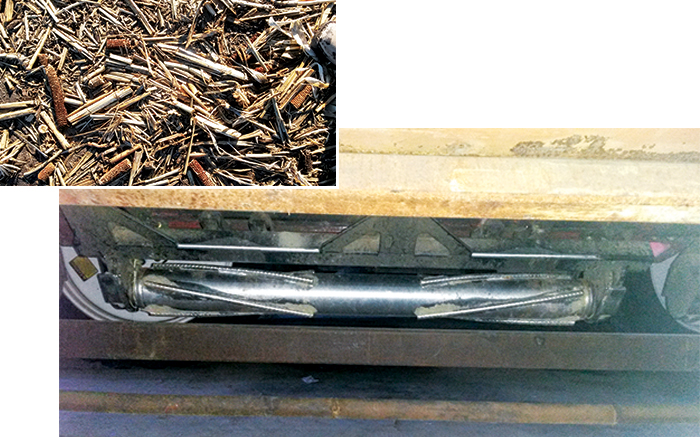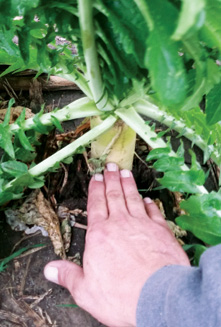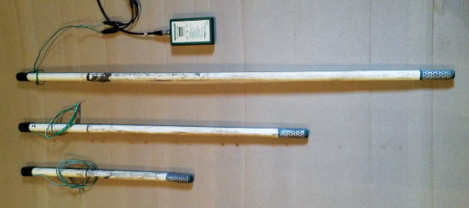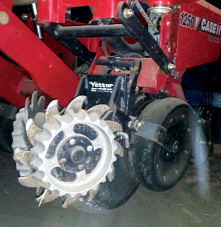Above photo: (L-R) Neat Ruwe, Elli, Chad, Tyler and Dawn Christianson, John Ruwe
By Chad Christianson
As interviewed by Martha Mintz
Check The Specs...
NAME: Chad Christianson
FARM: CDC Farms
LOCATION: Hooper, Neb.
YEARS NO-TILLING: 8
ACRES: 1,200
CROPS: Corn, soybeans, seed corn and seed soybeans
When I started farming with my father-in-law, John Ruwe, I thought I was at a real disadvantage to my peers who came from generations of farm families — those who had the opportunity to farm day in and day out alongside their parents and grandparents.
After speaking with some farmers on the other side of that experience, though, I’ve changed my tune.
Coming into farming with a relatively clean slate means I’m not stuck in the rut of doing things the way they’ve always been done. I’m constantly seeking education on farming techniques and management strategies, and I’m open to giving them a try if the science makes sense.
As a result, I’ve been able to make some major changes on our farm, including going 100% no-till as of 2009.
My parents made their exit from farming, like many others, in the early 1980s when I was just a young child. My uncles still farmed so I had the opportunity to ride the bean buggy or drive a grain cart at harvest, but I was never on the farm full time.

SHREDDING STALKS. Chad Christianson added the Yetter Stalk Devastator to his corn head to push root balls into the ground and lay stalks over. It helps speed residue breakdown and the stalks are easier on his tires.
My wife, Dawn, came from a farm family. When we married, her parents — John and Neat — were both very much active in the operation. They didn’t need much help so we pursued work in agriculture elsewhere. As John grew older, he started asking me to come assist him more and more, eventually bringing me on to help full time.
We had worked together for about 5 years when he offered to rent me a piece of ground. He kept gradually involving me more and more, and here we are today, with him retiring as of 2016 and me taking over the entire 1,200 acres of Northeast Nebraska farm ground.
Being inexperienced in farming, I made it a point to attend as many University of Nebraska field days and meetings as I could. One of the first things that really stood out to me was how inefficient tillage was. There had to be a better way of doing things. There was a better way — no-till.
No-till was a recurring topic in the meetings I attended. It just made so much sense to me. We could save moisture, prevent erosion and save a lot of time, energy and expense in field work. After talking the practice up to John, he had me put my money where my mouth was, as the saying goes.
Planter Investment
We first gave no-till a shot in 2008 using our early 1990s model John Deere 7200 planter. It was pretty light duty and didn’t do a great job. We struggled to get good seed placement and the crop really wasn’t up to par. But it wasn’t terrible and we thought we could make no-till work.
The planter, however, wouldn’t. It was going to need a major overhaul to make it work for no-till and it was aging anyway, so we decided to update the planter. John suggested I make this my first equipment purchase and turned the reins over to me.
After some research I decided to go with a 16-row Case IH 1250 planter with hydraulic drive and 30-inch spacings. I really liked the whole row-unit design — especially the offset opening discs, which I felt would be an advantage in a no-till situation.
The upgraded machine brought us much-needed weight and the advantages of Yetter floating row cleaners with depth bands and pneumatic down pressure. With our old planter we didn’t have a down-pressure system and the row cleaners had to be manually adjusted. It was so much easier to get the Case IH planter ready to go for planting.
The first growing season we saw a huge advantage in singulation, planting depth and spacing consistency. Despite being very nervous about going no-till, my father-in-law had to admit when driving by the field that first year it looked a lot better than our previous effort and even better than when we conventionally tilled.
Water Watch
About 80% of our fields are irrigated with center pivots. In the next couple of years following our switch to no-till we noticed our soil structure was improving and we didn’t seem to need to water as much as our conventional-farming neighbors. We seemed to be losing less water to evaporation and getting better use of the water we did apply.
While a lot of our early observations on water use in no-till were anecdotal, we’ve recently been given the opportunity to keep a close eye on how well our water is working for us.
Through a cost-share program we purchased WaterMark sensors, which are moisture sensors placed in the soil at 1-, 2- and 3-foot depths. We take readings from the sensors once per week during the irrigation season, and a computer program tells us how much plant-available water we have and how long until we need to water again.
To come to this calculation we input information such as soil type, crop, crop stage and root depth. We can go to the University of Nebraska website to find that corn at V6 stage is using ¼ inch of water per day.
Combined with the sensor information we’re then able to determine how long we can go before plant stress occurs and calculate irrigation as needed. One of our units has a rain bucket and solar panel to keep track of irrigation and water from rain so we can track those data points, too.
Because we have sensors in each of our fields, we’ve been able to see how residue impacts moisture. When it gets up to 100 F in July and August we’ve seen a definite difference in water use between mostly bare soils and those with residue cover.
The period of time when we need to turn on our pivots can differ from a couple days to a full week, depending if the field is planted into soybean stubble as compared to a field with more residue.
This information tells us our no-till residue is definitely helping hold moisture in the soil. The combination of no-till and water sensors means we’re not overusing water and protecting the resource for future farmers.
We also like the precision control this sensing system gives us. We’re able to walk a fine line between causing crop stress and not over-saturating our soils. This is critical, because overwatering means crop roots won’t dig deeper into the soil profile to find more nutrients and moisture. We want the plant to go searching for those nutrients and support itself.
Connecting Tech
One challenge we struggled with was interpreting the data we collected.
When we updated to a Case IH combine, we also gained the ability to monitor and map yields. We would take the data cards out and have the maps printed. They were nice and pretty, but that was about it. We could see good spots and bad spots, but we didn’t have the ability or knowledge to do much with that information.
Then the hydraulic drive on our new planter gave us the ability to variable-rate populations. We had the tools, so we started doing some grid soil testing to tell us why some of the areas were yielding better than others. All the pieces of the puzzle came together, and now we use all that information to variable-rate our populations at planting.
The corn populations on our irrigated acres range from 32,000-36,000 seeds per acre, and dryland between 26,000 and 30,000 seeds per acre. If I put too many seeds where my fertility or soil conditions aren’t ideal, then one or more of those seeds will become an inferior plant and act as a weed in the system. Now I’m saving money by using my seed more strategically and essentially not creating a weed in my row.
Tracking Soil Health

HEALTH CHECK. As Chad Christianson began evaluating his soil health and the progress he’s made, he’s looking to cover crops to take his production to the next level.
We’re also using our increasing knowledge of our field conditions to have our co-op variable-rate apply phosphorus (P), potassium (K) and micronutrients, which has saved money. Liming is another key.
From all the meetings I’ve attended on soil fertility and soil health, the big take-home was if pH isn’t ideal, it will rob yields. It’s the first number I look at when I get my soil test results. We spread lime as needed in a maintenance system to keep our pH close to neutral.
The second number I look at is soil organic matter. We’ve seen that number increase with no-till and we know that the higher it gets the more water our soils can hold, the better our soil microorganisms can work and the more P and K we can release from the soil to the plants.
We’ve moved on from just decreasing field work and preventing erosion, and now I’m looking at the health of our soil and how I can promote advances in that area.
My local extension agent talked me into doing a soil health test with Midwest Laboratories in Omaha, Neb., last fall. The soil-health assessment includes an in-depth chemical analysis for available nutrients and micronutrients and other typical results, but then goes a couple steps further. They do a Solvita soil respiration test, which measures microbial activity in the soil.
According to Midwest Laboratories, microbial activity is highly related to the fertility of your soil and a great indicator of overall soil health.
A third test, the Haney test, uses an extract that mimics organic acids produced by living plant roots to show what nutrients plants can extract from the soil.
All these together give an overall soil health calculation number ranging from 0-50.
Native prairie in our area tested at 17.3. After nearly 7 years of no-till I was hoping for some high numbers. My irrigated ground came in at 5.2 and 6.4, and a dryland field came in at 7.1. I think the dryland number can be attributed to some municipal sludge we applied to the field a few years ago.
Now that I’m looking at soil health, I’m experimenting with cover crops to help push up organic matter, increase soil cover and drive soil health to the next level.
Our seed-corn acres provide a great opportunity to use cover crops as we go in and stomp the male rows out in August. This leaves a nice open area to get a cover crop started. Within a week of taking out the male corn we flew on radishes, turnips, crimson clover, vetch and winter wheat. We got a timely rain and the stand was amazing.
We flew winter wheat, crimson clover, turnips and mustard on some of our soybean acres after 50% leaf yellowing. We were a little late getting the plane and the stand didn’t look great after harvest.
We did have a great fall, though, and while I’m disappointed with the top growth I know what’s going on underneath the soil is just as important, so I have high hopes for spring. I’m looking forward to what cover crops might do for us.

|

|
| WATER SENSE. These moisture sensors tell Chad Christianson exactly when he needs to water to benefit his growing crops. They’ve also revealed soils covered by residue from no-till don’t need water as much or as often. | PATH MAKERS. Floating Yetter row cleaners with depth bands have helped Christianson achieve more uniform seed placement with no-till. |
Tire Saver
While our residue has proven helpful in so many ways, it does have some drawbacks. Our tires took the brunt of our conversion to no-till.
Corn stalks left from the previous year damaged planter and tractor tires, which slowed field work and piled up extra expenses. Our solution was to add a Yetter Stalk Devastator system on the bottom of our 8-row corn head.
Three 8-inch cylinders hang about 2 feet below the row units. Each cylinder has rebar-like metal pieces welded to it at angles. When the header is lowered, the cylinders are pressed into the ground with spring pressure.
The rollers push root balls into the ground and lay stalks over. The ribbing smashes cornstalks, splitting them open a bit and allowing more moisture to penetrate the stalk over winter, speeding decomposition. When we plant the next year, the stalks break apart a lot easier when they’re hit by the planter’s opening disc.
The Yetter system was about an $8,000 investment, but at $2,000 per tire it doesn’t take long to recoup that cost.
Adding row clutches allowed us to leave far less unplanted ground, helping us eliminate weeds…
Another technology that really fit our system was adding Trimble’s Tru-Count row clutches to our planter. When raising seed corn we will often plant female seed first and come back in a later pass with the male seed. We don’t want to mix the male and female seeds in the end rows so we end up with a lot of point rows.
Leaving those big triangles of unplanted area was a huge attraction for weeds. Adding row clutches allowed us to leave far less unplanted ground, helping us eliminate that specific weed issue.
Water use, equipment, cover crops, nutrient management and more have all been tweaked in the past few years and I look forward to more change in the future.
I will never forget going to a fungicide meeting about 2 years ago. Randy Dowdy, who has taken home many yield awards in Georgia, spoke at the event and asked if anyone was happy with their yields. Not many raised their hands.
Then he asked how many were trying something new every year. Again, there weren’t many hands going up. He asked, ‘How are you going to increase yields and profits if you’re doing the same thing year after year?’
You have to try new things. That stuck with me and that’s what I’m trying to do.







Post a comment
Report Abusive Comment